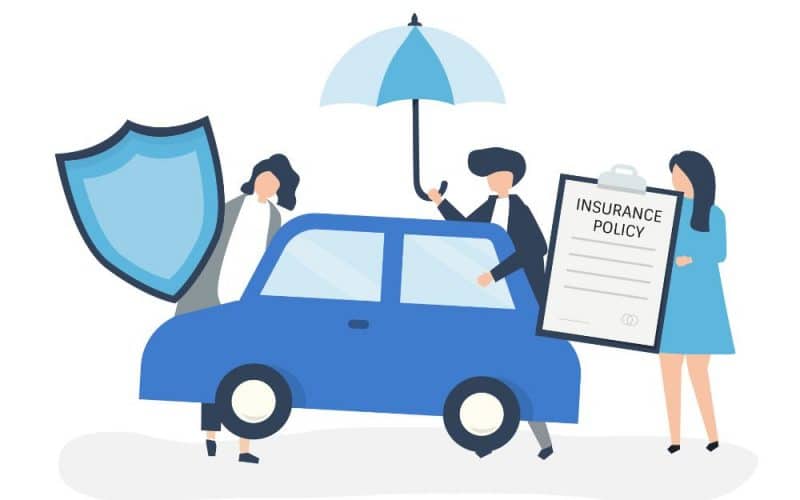An automobile insurance policy is a contract between you and the insurance company that protects you against financial loss in the event of an accident or theft. In exchange for your paying a premium, the insurance company agrees to pay your losses as outlined in your policy.
Basic personal auto insurance is mandated by most states and provides you with some financial protection in case of an accident. An automobile insurance policy provides coverage for:
- Liability – your legal responsibility to others for bodily injury or property damage
- Property – such as damage to or theft of your car
- Medical – the cost of treating injuries, rehabilitation and sometimes lost wages and funeral expenses
Basic personal auto insurance is mandated by most states, and laws vary. Auto insurance coverages are priced individually (a la carte) to let you customize coverage amounts to suit your exact needs and budget.
Policies are generally issued for six-month or one-year timeframes and are renewable. The insurance company sends a notice when it’s time to renew the policy and pay your premium.
What is an automobile insurance policy?
An automobile insurance policy is effectively a contract between yourself and an insurance company in which you agree to pay premiums in exchange for protection against financial losses stemming from an accident or other damage to the vehicle. Auto insurance can offer coverage for:
- Vehicle damages, including your car or another driver’s vehicle
- Property damage or bodily injuries caused by an accident
- Medical bills and/or funeral expenses associated with injuries sustained in an accident
The exact details of what’s covered depend on the minimum coverage requirements for your state and any additional coverage options you choose to include. Every state except New Hampshire requires drivers to have a minimum amount of bodily injury liability coverage and property damage liability coverage.
Types of automobile insurance policy
Depending on where you live, you may be required to purchase one or more of the following.
Liability insurance
Liability car insurance pays others when you cause a car crash that results in damage or injuries to others. It also pays for your legal defense in case you’re sued because of an accident. Here are some examples of what liability insurance covers:
- You crash into your neighbor’s fence
- You rear end someone at a traffic light and damage their car
- You cause a car accident and the other driver is hurt
Liability car insurance covers accident-related injury and property damage expenses incurred by other drivers and their passengers if you’re at fault for an auto accident. It aIso covers legal expenses, settlements and judgments if you’re sued after an accident. It is required in every state, except in New Hampshire (where you don’t have to carry auto insurance if you can meet the state’s minimum financial responsibility requirements) and Virginia (where you can pay an uninsured motorist fee of $500 instead of buying car insurance).
Even in those states, buying an auto insurance policy is the easiest way to ensure you’re well-protected if you cause a car accident.
The minimum required amount will vary depending on your state. It’s better to buy more than your state’s minimum. That’s because state minimums can be woefully inadequate if you cause an accident with multiple injuries. You’ll be on the hook for any medical expenses above your policy limits.
You’ll want enough liability insurance to cover what can be taken from you in a lawsuit.
Collision and comprehensive insurance
Collision insurance covers damage to your own vehicle after a collision, such as with another vehicle or a pole. Comprehensive coverage pays for specific damage caused by non-collision events, such as theft, floods, fire, falling objects and vandalism.
If you want coverage for car repair bills, collision and comprehensive insurance cover a wide range of problems. They’re often sold together. If you have a car loan or lease, your lender or leasing agent will likely require you to carry both of them.
If you file a claim under one of these types of auto insurance, your insurance claims check will be reduced by your deductible. For example, if you have a $500 deductible and your car repair bill is $2,000, your insurance check will be $1,500.
Medical Payments (MedPay)
Medical payments coverage, sometimes called MedPay, covers medical bills for you and your passenger for injuries suffered in a car accident, regardless of who caused the accident. It’s usually sold in small amounts of coverage, often between $1,000 to $5,000.
MedPay is not available in every state.
Personal Injury Protection (PIP)
Personal injury protection (PIP) coverage is similar to MedPay and covers medical expenses for injuries suffered in a car accident for you and your passengers, no matter who caused the accident. PIP generally pays for:
- Medical bills for car accident injuries
- Lost wages if you cannot work due to injuries
- Rehabilitation costs
- Replacement services for things you can’t do because of injuries, like child care or cleaning services
- Funeral expenses and survivor benefits
Many states require PIP and it’s sometimes part of the “no-fault auto insurance” laws, which generally require you to make smaller injury claims on your own PIP insurance. PIP is optional in some states and not available in others.
Uninsured motorist coverage
Uninsured motorist (UM) insurance and underinsured motorist (UIM) insurance pay for your medical expenses if someone crashes into you who has no insurance or not enough. It covers medical and injury-related expenses for you or your passengers if you’re in an accident with an uninsured driver. May also cover damages to your vehicle, depending on your state.
However, this automobile insurance policy does not pay the driver who’s uninsured.
UM can also pay for your medical expenses if another driver’s insurance denies coverage or goes out of business. Drivers who live in states that require drivers to carry uninsured motorist insurance will need. It may also be especially helpful to those who don’t have health insurance to cover their medical costs if injured by an uninsured driver.
UM coverage pays for:
- Medical bills of you and/or your passengers
- Lost wages if you can’t work due to injuries from a car accident
- Pain and suffering
- Funeral expenses
- Car damage, depending on your state
Uninsured motorist insurance is required in some states. In other states, your car insurance must offer you this coverage, but you can typically reject it in writing. UM is generally a good coverage to have. You’ll usually purchase UM in coverage amounts that match your liability insurance.
If you drive for a rideshare company like Lyft or Uber, there may be a coverage gap between the time you’re waiting for a ride request and driving to pick up a passenger. If you get into a car accident during one of these periods, you could be stuck paying for car repair bills and medical expenses out-of-pocket.
Rideshare insurance coverage can help cover those gaps.
Other types of automobile insurance policy
You can typically fill gaps in your car insurance policy by purchasing optional coverage types such as
- Gap insurance. If your car is totaled due to a problem covered by your policy (like a car accident), gap insurance covers the difference between what your car is worth and what you owe on the loan. For example, if you have $20,000 outstanding on your loan but the value of your totaled car is only $18,000, this coverage pays the $2,000 “gap.”
- Rental reimbursement insurance. If your car is being repaired for a problem covered by your policy, rental reimbursement coverage pays for a rental car or substitute transportation (such as public transportation fees).
- Accident forgiveness coverage. If you cause a car accident and have this coverage, your insurance company will “forgive” the accident and your insurance premiums won’t increase. While the rules for accident forgiveness insurance vary by state and insurer, it’s not an unlimited pass and is typically limited to one forgiven accident per policy for a certain timeframe, such as one at-fault accident every three years.
- New car replacement insurance. If your car is totaled due to a problem covered by your policy, this coverage will give you money for a brand-new car of the same make and model. New car replacement insurance can be a good coverage option for cars that quickly depreciate in value.
- Roadside assistance insurance. If your car breaks down on the side of the road, roadside assistance insurance pays for help such as a tow truck, locksmith, and other services, such as fuel delivery or a jump-start for a dead battery.
Automobile insurance policy costs
There are two primary costs associated with purchasing car insurance: premiums and deductibles.
Auto insurance premiums vary depending on the evaluation of several factors. Such factors include the applicant’s gender, age at the time of application, years of driving experience, accident and moving violation history, and other factors. Again, most states mandate a minimum amount of auto insurance. That minimum varies by state, but many people purchase additional insurance to protect themselves further.
Additionally, if you’re financing a car, the lender may stipulate that you carry certain types of car insurance. For instance, you may need gap insurance if you’re purchasing an expensive vehicle that will likely depreciate very quickly once you drive it off the lot. Gap insurance can help to pay off the difference between the vehicle’s value and what you still owe on it if you’re involved in an accident.
A poor driving record or the desire for complete coverage will lead to higher premiums. However, you can reduce your premiums by agreeing to take on more risk, which means increasing your deductible.
Your deductible is the amount you have to pay when filing a claim before the insurance company will pay out anything to you for damages. So, for example, your policy may have a $500 or $1000 deductible. Agreeing to a higher deductible can result in a lower premium but you’d have to be reasonably sure you could cover the higher amount if you need to file a claim.
How to estimate automobile insurance policy costs
There are a lot of factors that impact the premium you pay for car insurance, such as your age, location, driving history, car type, coverage limits, and deductibles. How these factors specifically impact your costs can vary between insurers.
Every insurance company has its own rating plan, or method for analyzing risk levels and calculating coverage costs. Insurers use statistics to identify factors that may lead to a loss, and then use that information to determine how much to charge.
The best way to get an accurate auto insurance estimate is to contact multiple insurers – a minimum of three, according to the Insurance Information Institute (III). Be sure and ask for multiple quotes for the same coverage levels to provide yourself with an accurate comparison.
Factors that affect automobile insurance policy rates
Insurance is an agreement between a policyholder (you) and an insurance company. In exchange for a monthly payment, or premium, the insurer agrees to cover you – or indemnify you – for certain losses or events to restore you to your previous financial position. This can include damage to your vehicle, injuries to you and your passengers, and injuries and property damage to third parties.
The amount you pay for your car insurance policy largely has to do with how likely you are to have an accident and make a claim. Insurers use a process known as underwriting to evaluate that likelihood and set rates accordingly. Other factors like your deductible and your state’s requirements can also impact your costs.
The following risk indicators are typically considered by underwriters when they calculate car insurance rates:
Annual mileage
The likelihood of getting in a car accident increases the more you drive. This is why high-mileage drivers often pay more for car insurance than low-mileage drivers. If there’s been a recent change in your driving habits, you should contact your agent to update your mileage estimates accordingly as it could save you money.
Credit score
People with good credit aren’t necessarily better drivers, but insurers view them as more financially responsible, and that responsibility is rewarded with better auto insurance rates. On average, drivers with good credit pay about 22% less than those with fair credit, a difference of about $337 per year.
Many insurers also use credit scores to calculate insurance scores to predict the likelihood a policyholder will file a claim.
Driver age
Younger drivers, especially teenagers, tend to have less experience behind the wheel than older drivers. Insurers relate inexperience to higher risk. Even if you are an experienced driver, your rates will likely go up if you add a younger driver to your policy.
On average, 35-year-old drivers can pay 20% to 25% less than 25-year-old drivers, according to our analysis of car insurance rates.
Driving record
If you’ve received a speeding ticket or been in an accident within the past three to five years, insurers view that as an indication of risky driving behavior, and they will typically raise your car insurance rates because of it. On the other hand, drivers with an accident-free record may receive a discount on their policy because they pose a lower risk.
The average annual cost of car insurance for drivers with a clean record is $1,547 per year, according to our rate analysis. A speeding ticket increases the average annual rate to $1,935, while a single accident raises it to $2,212. Having a DUI on your record is even more expensive at $2,675 on average.
Location
The risks associated with where you live can impact your car insurance costs. For example, drivers in large, high-traffic cities tend to pay more premiums than those in rural areas due to there being more cars on the road and higher vandalism and theft rates.
Marital status
In general, premiums are typically lower for married drivers than their single counterparts. In addition, combining your auto insurance policies may also make you eligible for a multi-car discount. However, if either you or your partner has a less-than-perfect driving record, you may not see any savings from sharing a policy.
However, it’s important to note that some states and insurers require spouses who live together to share a policy or be disclosed on each other’s policies unless certain criteria are met.
Safety features
You may qualify for savings on your insurance rate if your car has driver-assistance features that can reduce the chance of an accident, such as a collision-avoidance system or an anti-theft system.
Vehicle make and model
Generally speaking, non-luxury cars and SUVs are cheaper to insure than luxury vehicles because the cost to repair or replace these vehicles is lower. That said, auto insurance companies also look at a vehicle’s theft rate, safety features, and how a type of vehicle is typically driven. For instance, a sports car is usually pricier to insure than a minivan or family sedan.
Vehicle ownership
If you are financing your vehicle, your lender will likely require you to carry collision and comprehensive coverage until the loan has been paid off. If you lease your vehicle, similar coverage requirements may apply.
Recommended Articles
- Best Car Insurance for High-Risk Drivers
- Comprehensive vs Collision Coverage: What’s the Difference?
- Insurance For Uber Drivers: How It Works & Top Providers
- Can I Insure a Car Not in My Name? All You Need To Know
- Hagerty Classic Car Insurance: Prices & Review 2023
- Liberty Mutual Car Insurance: Review 2023






